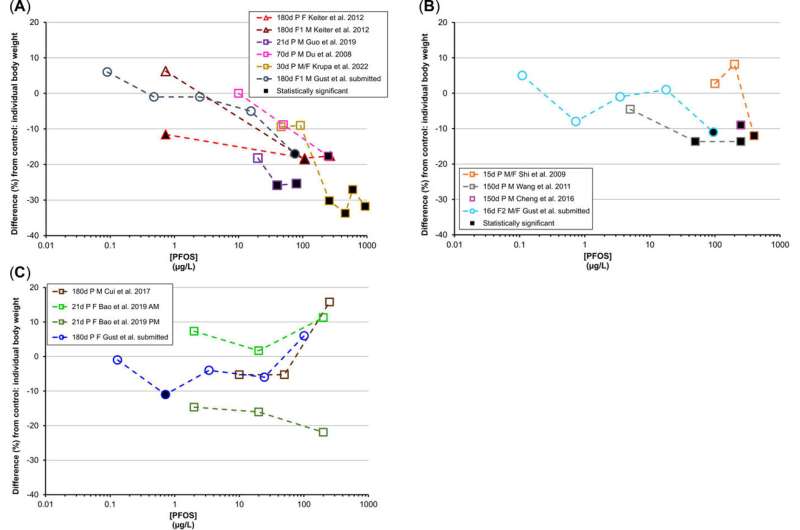
Change in body weight (wet wt, relative to control) of fish exposed to perfluorooctane sulfonate (PFOS). Credit: Environmental Toxicology and Chemistry (2023). DOI: 10.1002/etc.5768
Two papers recently published in Environmental Toxicology and Chemistry have made important advancements toward understanding the effects of perfluorooctane sulfonate (PFOS) on aquatic life, especially fish. Zebrafish had been identified in a previous study of limited scope as being among one of the most sensitive aquatic species to PFOS, and the results of that limited-scope study have influenced PFOS water quality criteria derived by some regulatory agencies, including the Australian Environmental Protection Agency (EPA).
Kurt Gust and colleagues (USACE, US EPA, and Geosyntec) recently conducted an enhanced replication of the original limited-scope study by testing a more significant number of PFOS concentrations, increasing the amount of replication, and confirming the presence of PFOS in the water more regularly. The more robust experiment conducted by Gust et al. indicated that the earlier results were non-repeatable and overly sensitive by roughly two orders of magnitude.
A complementary paper by Zacharias Pandelides and colleagues compared the experimental designs, study quality, and results of the previous limited-scope study, the Gust et al. paper, and other published aquatic toxicity studies that chronically exposed zebrafish to PFOS.
Overall, the review indicated that the Gust et al. results were comparable to those from the other studies, and that the results of the original limited-scope study may have been due to biological variation instead of an adverse effect of PFOS. Using a weight-of-evidence approach, Pandelides et al. recommended updated thresholds for the effects of PFOS on fish populations for use in regulatory criteria derivation and site-specific ecological risk assessments.
More information:
Kurt A. Gust et al, Survival, Growth, and Reproduction Responses in a Three‐Generation Exposure of the Zebrafish (Danio rerio) to Perfluorooctane Sulfonate, Environmental Toxicology and Chemistry (2023). DOI: 10.1002/etc.5770
Zacharias Pandelides et al, Establishing Chronic Toxicity Effect Levels for Zebrafish (Danio rerio) Exposed to Perfluorooctane Sulfonate, Environmental Toxicology and Chemistry (2023). DOI: 10.1002/etc.5768
Provided by
Society of Environmental Toxicology and Chemistry
Citation:
Improving our understanding of the effects of PFOS on fish (2023, November 29)
retrieved 30 November 2023
from https://phys.org/news/2023-11-effects-pfos-fish.html
This document is subject to copyright. Apart from any fair dealing for the purpose of private study or research, no
part may be reproduced without the written permission. The content is provided for information purposes only.
>>> Read full article>>>
Copyright for syndicated content belongs to the linked Source : Phys.org – https://phys.org/news/2023-11-effects-pfos-fish.html































